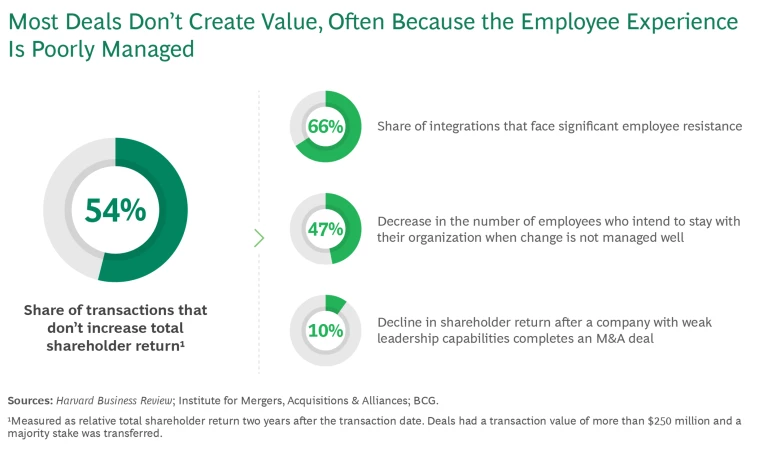Gaining the support of employees should be a top priority for post-merger integration (PMI) teams. Effectively managing the employee experience as part of the broader change management program is essential in order to capture the transaction’s value and lay the foundation for the future company. Leaders must communicate the integration’s value proposition to employees, listen carefully to their needs and concerns, and address these issues as effectively as possible. They also must equip employees with the necessary tools and skills to adapt to the organization’s new operating model.
However, many companies overlook or underfund efforts to maintain high morale and employee engagement during an integration, prioritizing other aspects of the complex PMI process. We frequently see a one-size-fits-all approach that fails to address the nuances of the employee experience across different departments and roles.
The stakes are high. BCG’s analysis found that more than half of transactions fail to increase total shareholder return. (See the exhibit.) Poor management of the employee experience is often a major contributor to disappointing performance. Two-thirds of mergers face significant employee resistance, and the number of employees who intend to stay with their organization drops by nearly 50% when change is poorly managed. The reason is clear: Integrations are stressful and highly disruptive for employees. When change is not managed effectively, morale plummets and key personnel often depart for new opportunities.
To conduct an effective PMI employee experience program, companies must tailor their efforts to the unique context of the integration. We have identified five key change management lessons that point to five best practices for implementing a successful employee-experience program.

The Key Lessons Learned
Our client work points to the importance of context, customization, employee support, leader involvement, and two-way communication.
Context matters. The objective of the deal—whether growth, cost cutting, or a turnaround—shapes employee sentiment and determines which employees are affected. Each objective necessitates a tailored change management approach.
The nature of the deal also influences which departments and roles are prioritized in the change management program. A merger of equals demands that efforts focus on employees from both organizations, whereas a straight-up acquisition requires that more attention be paid to the acquired company’s employees.
In addition, the cultural contexts and prevailing sentiments about the integration at both organizations dictate the necessary change management strategy. Considerations should include the cultural differences between the organizations, their histories of M&A, employees’ perceptions of the other company, and the existing level of employee satisfaction. For instance, if either company has had a negative experience with a past integration, this can significantly influence employees’ attitudes and expectations for the current process—they often anticipate that the new integration will also proceed poorly.
Customization is critical. Because the degree and type of impact vary across employee positions, companies must customize the change management program for each affected role. In addition, employees in the same role will have a different integration experience depending on whether they work at the acquiring company or the one being acquired. Their experience will also vary depending on the type of transaction, such as a combination of two large companies versus a tuck-in of a smaller company.
The vision and value thesis for the transaction are other factors that are relevant to customization. For example, a growth-focused value thesis may create opportunities for expanding the sales staff, while one that emphasizes cost cutting will likely lead to back-office staff reductions.
Employees in the same role will have a different integration experience, depending on the type of transaction, the vision for it, and the value thesis.
Moreover, the value thesis, and whether divestitures and operating model changes are needed, will also affect various departments and roles throughout both organizations in distinct ways. For example, most departments will be affected by the integration of companies with overlapping products or services. However, for a growth-focused thesis, collaboration between the sales organizations or product development functions will be the top priority.
Employees’ emotional engagement is essential. An employee’s experience during the integration process is often deeply personal. Many companies overemphasize metrics and goals while neglecting the softer aspects of a change management program. Leadership must engage the hearts—not only the minds—of individuals across the organization, demonstrating the benefits of the integration to multiple cohorts and winning their support.
Leaders need to take control. PMIs are not a spectator sport. Current leaders need to be deeply involved in executing the integration strategy, whether or not they have been selected to lead the future organization. Without their support, the integration will likely falter.
Change management is a two-way street. Consistently gathering employees’ perspectives and feedback is crucial for successful PMIs. Because they are long and dynamic, employee sentiment evolves as changes unfold. Reactions to the implementation phases can vary, requiring nuanced consideration of the employee experience throughout the integration process. By understanding employees’ perspectives and feedback, management can respond appropriately and develop intervention strategies for any areas of concern.
Five Best Practices
Integration teams can use the following practices to apply the key lessons and effectively manage the employee experience.
Clearly define the integration’s objectives. Identify and clarify the goals of the integration by analyzing its context.
Each company’s goals for the deal—for example, spurring growth or achieving cost synergies—are an important part of that context. So, too, are the effects that the deal will have on each company, such as changes in its regional presence and regulatory requirements.
The context further encompasses the culture of both organizations in their steady state and concerning the integration. Tools, such as culture surveys and leadership belief audits, can help establish a cultural baseline for both organizations, identify similarities and differences, influence the integration’s objectives, and establish a common path forward for the culture as well as the overall integration.
For example, after acquiring a smaller player with a presence in South Africa, an international consumer goods company conducted a culture assessment that highlighted the importance of local knowledge and relationships in that country. This led to defining a priority objective for the integration: to deepen the understanding of the South African market across the organization and increase the focus on local customers.
After assessing the conditions surrounding the deal and their implications for the integration, the PMI team should produce a list of five to seven objectives for the employee experience program and disseminate this list to leaders in both organizations.
Create personas and journeys across the organization. Identify the various areas—such as internal and external functions, regions, and stores or branches—that make up a company’s organization structure. For each area and its employee roles, assess the level of change. Understand the specific requirements, such as alterations to a function’s organization structure, changes in how its jobs will be carried out, and adjustments to its role in transition services agreements.
Establish the areas that will be highly impacted by the integration and develop personas—fictional people—to represent the roles in those areas. For each persona, create a journey that guides the PMI team’s efforts. (See “Creating Personas and Journeys to Support Integration.”)
Creating Personas and Journeys to Support Integration
The number of personas depends on the size and complexity of the organization. At least 10 to 20 are typically needed. We recommend developing personas for groups experiencing high levels of change owing to the integration or divestiture. Personas for groups with lower levels of change may also be helpful to the PMI team—for example, because these groups will be supporting the integration by providing transition services.
For each persona, the team should map out the journey—the timeline of events—from the present until day one of integrated operations. For example, the journey details the essential communications each persona will receive and when. These include major announcements relating to leadership changes, the date that integrated operations will commence, and other moments of truth. The journey also outlines crucial decisions that the employees in each persona will need to make and the training sessions they should attend. Additionally, the journey specifies the key questions that are likely to be top of mind at various points for the employees in each persona.
For example, a large retail-chain integration was highly complex given the divestiture of some retail sites and a period of transitional services. The impact on employees varied widely across the organization, necessitating the creation of more than 35 personas to fully understand the effects. The integration team then developed a journey for each persona. The integration team tested its communications plans, leadership enablement, and training approaches directly with each persona.
Communicate more than just the facts. Explain to employees the integration’s value proposition for them, connecting personally and emotionally. Begin by identifying their key questions about the integration process—for example, how will their work methods, personal roles, and team dynamics change. Continue gaining these insights as the integration proceeds and performing think-feel-do analyses to define what employees should to know about the integration, how they should feel, and the actions they should take to ensure its success.
Incorporate these findings into the PMI team’s communications plan. Frequently reinforce the personal benefits of the integration, such as opportunities for expanded responsibilities, increased visibility to senior leadership, and new professional challenges. Winning the hearts and minds of employees, particularly those not selected for leadership roles in the new organization, is crucial for a successful integration.
For example, after a major health care merger, the integration team assessed the level of the merger’s impact on employees and then customized a communications approach. Leaders were provided with materials that made the case for the change while maintaining trust and reducing uncertainty. Feedback was solicited throughout the integration process, leading to additional support measures. These included hosting teach-in calls to enhance integration workstream teams’ understanding of business areas and organizing virtual boot camps to address tactical collaboration challenges and interdependencies.
Engage leaders early and often. Ask leaders from both organizations to co-create the integration strategy before rolling it out broadly, and provide them with a playbook that guides their employee-experience efforts.
To develop a playbook for leaders, assemble a working team of executive sponsors from both organizations. Clearly define the playbook's goals, outline its chapters, and develop corresponding tools and training programs to support these objectives. Share the playbook with key stakeholders (for example HR leaders, communications specialists, and people managers) and iterate as needed to ensure leadership alignment.
Develop a playbook for leaders so that they feel informed, supported, and equipped to guide an employee experience program.
Develop a plan to roll out the playbook. Enlist leaders to engage in both live and recorded training sessions, as well as question-and-answer sessions. In addition, formulate a strategy for ongoing check-ins after the rollout. As a result of this effort, leaders should feel informed, supported, and equipped to help guide an effective employee-experience program.
For example, in a major retail-chain integration, the PMI team collaborated with both companies’ HR, training, and communications teams to develop a comprehensive playbook. It prepared leaders for major milestones across three phases of the integration. It served as a one-stop shop for leaders’ questions and provided talking points for addressing critical issues. The playbook equipped leaders to have difficult conversations with their teams, listen effectively to employees, and engage them in one-on-one settings.
Ensure two-way communication to assess impact. Establish a process that promotes ongoing two-way communication with employees. This process should include conducting pulse check surveys every six to eight weeks to monitor employee morale and engagement. These pulse checks can also identify emerging concerns among employees early and enable developing precise and swift resolutions before issues become more widespread and significant.
In addition, appoint change liaisons to facilitate the exchange of information and feedback between leaders and employees. Choose well-respected individuals with strong company-wide networks. They should be trusted by management and peers, represent the workforce’s diversity, be culturally sensitive, and have high integrity. Change liaisons provide a “safe space” for employees to raise questions, concerns, and feedback that they may not be willing to raise directly with their manager or leadership team. This is often a good opportunity for high-potential middle managers.
Throughout a long integration, a large financial institution conducted periodic pulse checks, especially during organizational design waves and at critical milestones. It addressed identified pain points with interventions to stabilize and energize the combined organization. It also designated approximately 50 change liaisons, creating an additional feedback loop between employees and the integration team.
Companies that skillfully manage the employee experience significantly enhance the chances of a successful integration. Key indicators of success include the following:
- Employees are excited about the new opportunities in the merged company.
- Employees feel that they were treated fairly, regardless of whether they were chosen for the future organization.
- Pulse check results show increasingly positive trends (for example, improving employee sentiment and a better understanding of the integration vision) as the integration progresses.
- The integration team promptly and effectively addresses employees’ concerns, such as those relating to changes in roles or ways of working.
By understanding the key change management lessons and implementing appropriate actions, companies can win both hearts and minds and ensure that the employee experience increases the value captured through integration.












